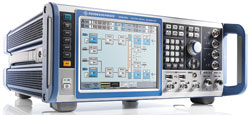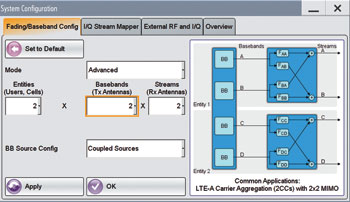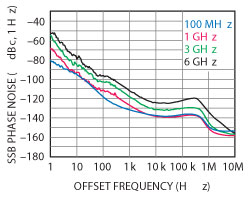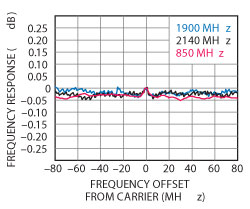
Mobile services and data-intensive applications demand increasingly powerful communications networks. To meet the data throughput requirements of end users, modern wireless standards are constantly enhanced, revealing a number of interesting trends. Firstly, the transmission bandwidth is constantly growing. GSM channels previously had a bandwidth of just a few hundred kHz. Today, LTE carriers occupy up to 20 MHz of the spectrum. Wireless standards such as WLAN IEEE 802.11ac even have bandwidths of up to 160 MHz.
Secondly, several carriers are grouped together and simultaneously used for information transmission. LTE-Advanced, for example, defines aggregation of up to five carriers, yielding a total bandwidth of 100 MHz. All modern wireless communications standards are based on MIMO to increase spectral efficiency, leading to the development of higher-order MIMO (4×2, 4×4, 8×2).
As a result, transmit and receive units of wireless devices and base stations are becoming increasingly complex. A wide variety of different wireless standards and bands must be supported. All of these advances are producing new T&M challenges: Developing and verifying products requires signal generators that are able to meet new requirements and are easy to operate, even with complex tasks. Rohde & Schwarz has addressed these requirements with the new R&S SMW200A vector signal generator.

Figure 1 System configuration menu for selecting the required test setup.
Simple setup
The R&S SMW200A generates signals in the 100 kHz to 3 or 6 GHz frequency ranges. It features an extremely powerful and flexible baseband section, making it a good tool for generating digitally modulated signals required for the development of wideband communications systems and the verification of 3G and 4G base stations. Thanks to its modular design, the new vector signal generator can be customized to meet user requirements. Any configuration is possible, from a classic single-path vector signal generator to a multichannel MIMO receiver tester.
The R&S SMW200A can be equipped with two internal baseband modules, four fading simulator modules and two RF paths. This concept yields two full-featured vector signal generators in a single unit. Signals can be internally added with frequency, level and phase offset, so that signal scenarios such as wanted signal + interferer, dual cell and Tx/Rx diversity with real time fading can be created very easily.
If necessary, the baseband section provides up to eight independent signal sources and up to 16 logical faders. This makes the R&S SMW200A suitable for generating multicarrier and multi-standard test signals required for LTE Advanced carrier aggregation and the simulation of interferer scenarios. 2×2 MIMO, 8×2 MIMO for TD-LTE or simultaneous 2×2 MIMO for two LTE-Advanced component carriers – even complex MIMO scenarios can be implemented using a single device. Figure 1 shows an example of how to configure an LTE-A carrier aggregation scenario with two carriers and 2×2 MIMO.

Figure 2 Compact 4 × 4 MIMO solution, consisting of an R&S SMW200A and two R&S SGS100As.
If more than two RF sources are required for applications, the R&S SMW200A can be expanded with external R&S SGS100A signal generator modules. These modules are remote controlled via USB or LAN directly from the R&S SMW200A and seamlessly integrate into its user interface. This compact solution takes up only five height units, as shown in Figure 2, and is ideal for applications such as 4×4 MIMO, providing correctly encoded baseband signals, real time MIMO channel simulation, AWGN generation and, if necessary, phase-locked coupling of multiple RF paths.
Speeding up development

Figure 3 SSB phase noise (with R&S SMW-B22 option).
When the R&S SMW200A user interface was designed, special emphasis was placed on ergonomics. Its intuitive user guidance and numerous help functions make it very easy to operate, even with complex signal scenarios. The generator is equipped with a graphical block diagram that can be operated from a high-resolution touch screen. The signal flow can be seen at a glance at any time since the GUI adapts itself to the selected operating mode.
Graphical signal monitoring (spectrum, I/Q, CCDF, etc.) makes it possible to monitor the generated signal at practically any point of the signal flow. The required test signals can be configured directly via the GUI, eliminating the need for external PC software. Together with predefined settings and test models for all major digital standards as well as test case wizards for 3GPP FDD and LTE base station conformance testing, this helps to speed up work.
The context-sensitive help system including remote commands (SCPI) and further information assists users during everyday work. Functions such as marking all changes to settings after a preset or selective preset for individual parameters are extremely useful. The R&S SMW200A is equipped with an innovative SCPI macro recorder for generating remote control code (e.g., plain SCPI, Matlab®, etc.) from manual operating steps, enabling users to create an executable remote program within seconds. The macro playback engine makes it possible to run sequences directly on the signal generator, speeding up development processes and saving resources.
Better product results

Figure 4 I/Q modulation frequency response with internal baseband.
In an environment that is characterized by high levels of competition, product quality is one of the key distinguishing features. The R&S SMW200A offers good signal quality and is suited for developing and optimizing high-end RF and baseband modules. When it is equipped with the R&S SMW-B22 option, the SSB phase noise has a value of only –139 dBc (typical) at 1 GHz carrier frequency and 20 kHz offset (see Figure 3). At the same time, non-harmonics are suppressed with up to 90 dB or more (see Appendix 1online listing the key specifications at www.mwjournal.com/RandSappendix).
The internal baseband has a 0.05 dB I/Q modulation frequency response over 160 MHz bandwidth, as shown in Figure 4. With wideband signals such as 256 QAM modulated WLAN IEEE 802.11ac, an EVM of –49 dB (measured) is achieved at the signal generator’s RF output. The R&S SMW200A makes it possible to generate standard-compliant wireless communications signals at a very high level.
With the R&S SMW200A, Rohde & Schwarz has significantly reduced test setup complexity in today’s increasingly complex wireless world. Since the R&S SMW200A combines the functions of several instruments in a single signal generator, many potential error sources such as remote operation, cabling and synchronization are a thing of the past. Its scalable platform allows users to tailor the signal generator exactly to their applications and to upgrade it as required. This helps to save investment costs and makes the R&S SMW200A a very safe investment for the future. The intuitive operating concept helps users accomplish their tasks faster, regardless of their complexity. The new vector signal generator provides the ideal framework for quickly and efficiently making high-quality products ready for market.
For further details, you can view this video with more information about the R&S SMW200A.
Rohde & Schwarz,
Munich, Germany
+49 89 4129 12345,
www.rohde-schwarz.com
